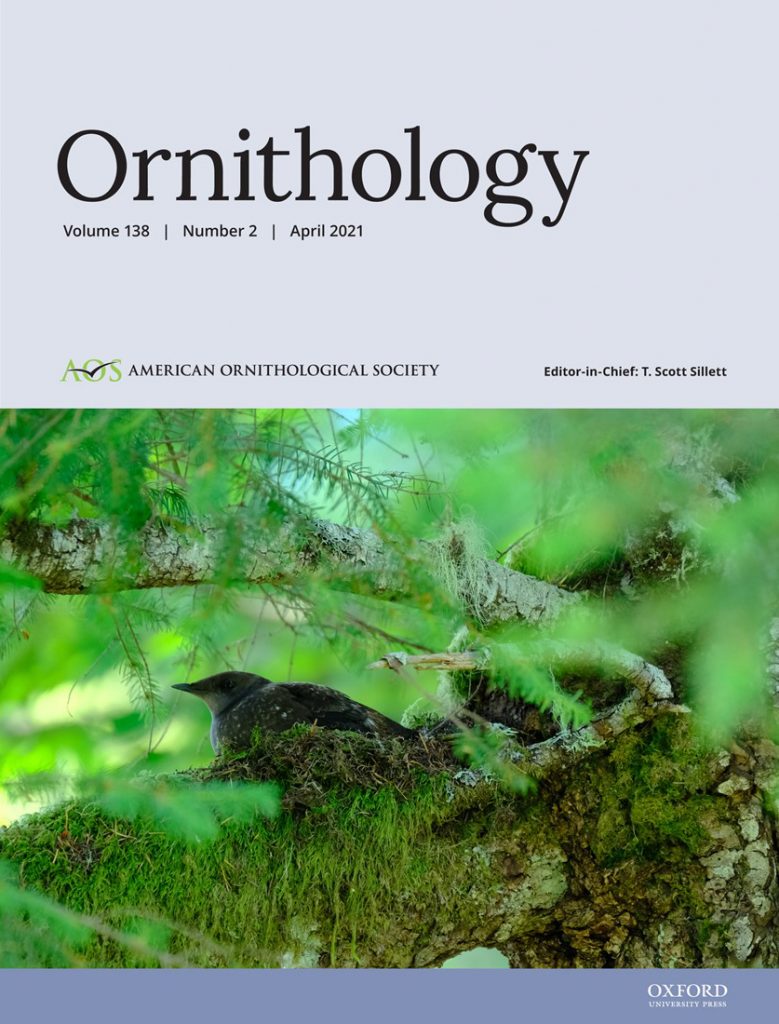
Cover Image: An adult Marbled Murrelet (Brachyramphus marmoratus) incubating its single egg in the central Oregon Coast Range. Photo by Brett Lovelace (photo owned by Oregon State University).
How we determine what entities we call species has major impacts on ornithology at many levels; the units used in every field of scientific research and that are the focus of conservation and legislative planning are the result of this data-driven process. Once species limits are decided, the scientific and English names that we use to facilitate communication about these units are determined following rules for the former and guidelines for the latter. They soon become entrenched and familiar through use in field guides, checklists, and listing apps including eBird. Avian species limits decisions reach well beyond scientific ornithology, given the public interest in birds and the intense involvement and contributions of birders.
The biological species concept (BSC) is by far the species concept most often used by global and regional avian taxonomic authorities, including the American Ornithological Society’s Checklist of North American Birds. Setting aside major philosophical disputes as to what is a species and what species concept should be employed, many contentious issues remain regarding the application of the BSC itself. Recent major strides in molecular systematics, analytical techniques, and publicly available resources and forums, though hugely informative and influential on species limits, in some instances have also led to conflicting datasets and exacerbated problems of interpretation.
At the AOS annual meeting in 2019, we organized an AOS symposium on this theme, entitled “Species Limits in Birds: Integrative and Practical Considerations for Taxonomy” to draw attention to and facilitate a discussion about the fundamental importance of and interest in these evolving issues within the BSC framework. Now, we’re pleased to present this Special Feature in Ornithology that grew out of that 2019 symposium, and we thank all the authors for their contributions. In our accompanying Perspective article, “Species Limits and Taxonomy in Birds,” we briefly review the broader topic and the overriding issues that both inform and plague species delimitation, thus in some cases leading to varying interpretations of the same data. We also introduce and provide capsule summaries of each contribution within the Special Feature. These contributions include more conceptual reviews of broader topics, as well as more applied analyses of species limits in specific cases. We hope you will find all these papers interesting and informative, and we look forward to future advances in the field. There is a lot of good work to be done.
— Pamela C. Rasmussen and Kevin Winker
Ornithology Special Feature: Species Limits and Taxonomy in Birds
Species limit and taxonomy in birds by Kevin Winker and Pamela C. Rasmussen
Integrative taxonomy and geographic sampling underlie successful species delimitation by Carla Cicero, Nicholas A. Mason, Rosa Alicia Jiménez, Daniel R. Wait, Cynthia Y. Wang-Claypool, and Rauri C. K. Bowie
The genomic revolution and species delimitation in birds (and other organisms): Why phenotypes should not be overlooked by Carlos Daniel Cadena and Felipe Zapata
Avian taxonomy in turmoil: The 7-point rule is poorly reproducible and may overlook substantial cryptic diversity by Frank E. Rheindt and Elize Y. X. Ng
Performance of a points-based scoring system for assessing species limits in birds by Joseph A. Tobias, Paul F. Donald, Rob W. Martin, Stuart H. M. Butchart, and Nigel J. Collar
An overview of speciation and species limits in birds by Kevin Winker
The American Kestrel (Falco sparverius) genoscape: implications for monitoring, management, and subspecies boundaries by Kristen C. Ruegg, Michaela Brinkmeyer, Christen M. Bossu, Rachael A Bay, Eric C. Anderson, Clint W. Boal, Russell D. Dawson, Amber Eschenbauch, Christopher J. W. McClure, Karl E. Miller, Lance Morrow, Jill Morrow, M. David Oleyar, Bill Ralph, Sarah Schulwitz, Ted Swem, Jean-Francois Therrien, Rich Van Buskirk, Thomas B. Smith, and Julie A. Heath
Morphology, vocalizations, and mitochondrial DNA suggest that the Graceful Prinia is two species by Per Alström, Pamela C. Rasmussen, Canwei Xia, Lijun Zhang, Chengyi Liu, Jesper Magnusson, Arya Shafaeipour, and Urban Olsson